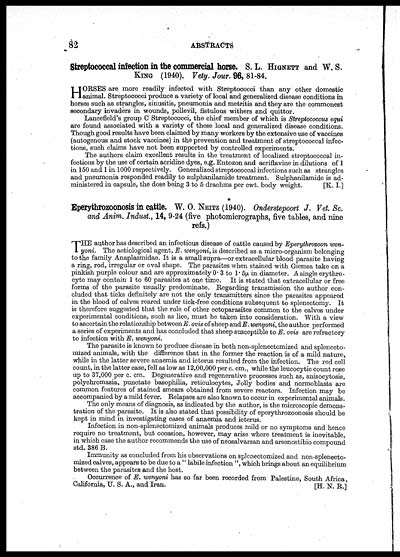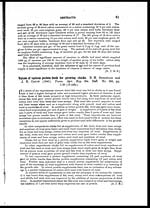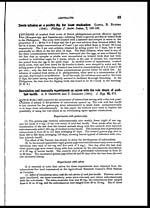Medicine - Veterinary > Veterinary colleges and laboratories > Indian journal of veterinary science and animal husbandry > Volume 12, 1942 > Original articles > Abstracts
(98) Page 82
Download files
Individual page:
Thumbnail gallery: Grid view | List view

82 ABSTRACTS
Streptococcal infection in the commercial horse. S. L. HIGNETT and W. S.
KING (1940). Vety. Jour. 96, 81-84.
HORSES are more readily infected with Streptococci than any other domestic
animal. Streptococci produce a variety of local and generalized disease conditions in
horses such as strangles, sinusitis, pneumonia and metritis and they are the commonest
secondary invaders in wounds, pollevil, fistulous withers and quittor.
Lancefield's group C Streptococci, the chief member of which is Streptococcus equi
are found associated with a variety of these local and generalized disease conditions.
Though good results have been claimed by many workers by the extensive use of vaccines
(autogenous and stock vaccines) in the prevention and treatment of streptococcal infec-
tions, such claims have not been supported by controlled experiments.
The authors claim excellent results in the treatment of localized streptococcal in-
fections by the use of certain acridine dyes, e.g. Entozon and acriflavine in dilutions of 1
in 150 and 1 in 1000 respectively. Generalized streptococcal infections such as strangles
and pneumonia responded readily to sulphanilamide treatment. Sulphanilamide is ad-
ministered in capsule, the dose being 3 to 5 drachms per cwt. body weight. [K. I.]
Eperythrozoonosis in cattle. W. O. NEITZ (1940). Onderstepoort J. Vet. Sc.
and Anim. Indust., 14, 9-24 (five photomicrographs, five tables, and nine
refs.)
THE author has described an infectious disease of cattle caused by Eperythrozoon wen-
yoni. The aetiological agent, E. wenyoni, is described as a micro-organism belonging
to the family Anaplasmidae. It is a small supra—or extracellular blood parasite having
a ring, rod, irregular or oval shape. The parasites when stained with Giemsa take on a
pinkish purple colour and are approximately 0.3 to 1.5µ. in diameter. A single erythro-
cyte may contain 1 to 60 parasites at one time. It is stated that extracellular or free
forms of the parasite usually predominate. Regarding transmission the author con-
cluded that ticks definitely are not the only transmitters since the parasites appeared
in the blood of calves reared under tick-free conditions subsequent to splenectomy. It
is therefore suggested that the role of other ectoparasites common to the calves under
experimental conditions, such as lice, must be taken into consideration. With a view
to ascertain the relationship between E. ovis of sheep and E. wenyoni, the author performed
a series of experiments and has concluded that sheep susceptible to E. ovis are refractory
to infection with E. wenyoni.
The parasite is known to produce disease in both non-splenectomized and splenecto-
mized animals, with the difference that in the former the reaction is of a mild nature,
while in the latter severe anaemia and icterus resulted from the infection. The red cell
count, in the latter case, fell as low as 12,00,000 per c. cm., while the leucocytic count rose
up to 37,000 per c. cm. Degenerative and regenerative processes such as, anisocytosis,
polychromasia, punctate basophilia, reticulocytes, Jolly bodies and normoblasts are
common features of stained smears obtained from severe reactors. Infection may be
accompanied by a mild fever. Relapses are also known to occur in experimental animals.
The only means of diagnosis, as indicated by the author, is the microscopic demons-
tration of the parasite. It is also stated that possibility of eperythrozoonosis should be
kept in mind in investigating cases of anaemia and icterus.
Infection in non-splenectomized animals produces mild or no symptoms and hence
require no treatment, but occasion, however, may arise where treatment is inevitable,
in which case the author recommends the use of neosalvarsan and arsenostibio compound
std. 386 B.
Immunity as concluded from his observations on splenectomized and non-splenecto-
mized calves, appears to be due to a " labile infection ", which brings about an equilibrium
between the parasites and the host.
Occurrence of E. wenyoni has so far been recorded from Palestine, South Africa,
California, U. S. A., and Iran. [H. N. R.]
Set display mode to: Large image | Zoom image | Transcription
Images and transcriptions on this page, including medium image downloads, may be used under the Creative Commons Attribution 4.0 International Licence unless otherwise stated. ![]()
| Permanent URL | https://digital.nls.uk/75259379 |
|---|
| Description | Covers articles from 1942. |
|---|




